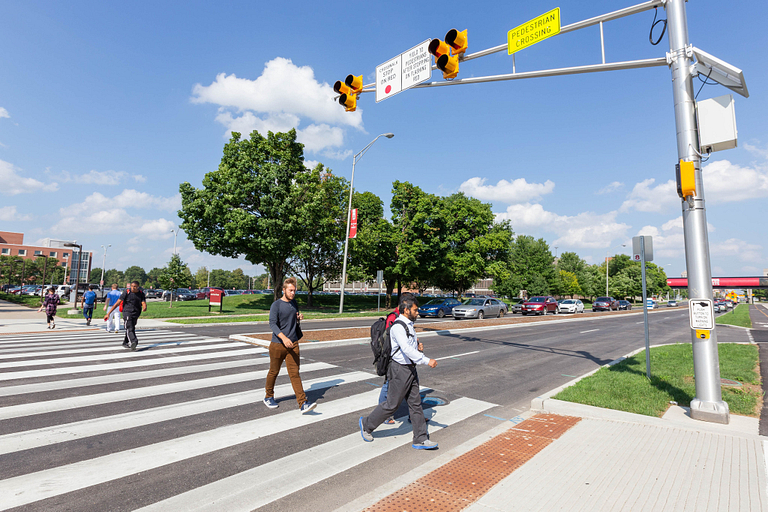
Whether you’re new or returning to the IUPUI campus this fall, the first few weeks of school can be confusing. Adding a variety of traffic patterns, new crosswalks, distracted drivers and tons of foot traffic makes it tricky to keep the roads safe, especially for pedestrians and cyclists.
In an effort to make highly populated streets safer for those on foot or two wheels, the city of Indianapolis recently installed HAWK lights at IUPUI.
There are four HAWK lights – which stands for High-intensity Activated crossWalK beacon – on campus: at the intersection of California and Michigan streets by the Informatics and Communications Technology Complex, on New York Street by the Education/Social Work Building, on Michigan Street at the IU School of Dentistry, and by the Engineering/Technology Building on Michigan Street.
But the Indiana University Police Department-IUPUI has noticed that the lights have caused some confusion for drivers, pedestrians and cyclists.
Here’s how they work: As a driver approaches a HAWK crosswalk, the beacon portrays one of five light signals to indicate what to do next.
- When no pedestrians are waiting to cross, the traffic light remains dark. With this, a driver can proceed without stopping.
- Once a waiting pedestrian has pressed the button to cross the street, the light flashes yellow. This signal lets drivers know the beacon is activated and that they should slow down.
- A solid yellow light lets drivers know they should be prepared to stop for foot traffic.
- Double red lights require motorists to stop completely and allow pedestrians to cross the road.
- Finally, as the walk phase for pedestrians winds down, an alternating, flashing red signal tells drivers they must come to a complete stop but can continue once everyone has cleared the walkway.
As walkers approach the crosswalk, the signal will have the hand icon, telling them not to proceed. To cross safely, pedestrians must hit the crosswalk button to trigger the beacon to cross. Once the button is pressed, the traffic light activates, and it will inform motorists that they need to be prepared to stop. When the “walk” signal appears, foot traffic may proceed across the street.
Even with the safety measures, IUPD-IUPUI Deputy Chief Bill Abston urges pedestrians and cyclists to take care crossing roads.
“Just because you’re at a crosswalk and you see a white indicator that means you can cross doesn’t mean you shouldn’t look both ways in case the driver doesn’t see you,” Abston said. “A lot of people driving around campus are looking for hospitals, are confused, stressed, lost or distracted. Even our pedestrians are distracted.”
He said that the increase of students and student housing both on and around campus has raised concern for pedestrian safety over the years. Also, he said, people tend to cross the street whenever and wherever they feel like it, and that can be dangerous.
“Pedestrian safety in general is a big concern for us,” Abston said. “As a result of the new HAWK lights, in addition to the campus safety campaign, Busy Campus Busy Streets, increased efforts in traffic safety and implementing motorcycle officers, we are helping to educate motorists, pedestrians and cyclists. This increased awareness will result in a safer campus.”

